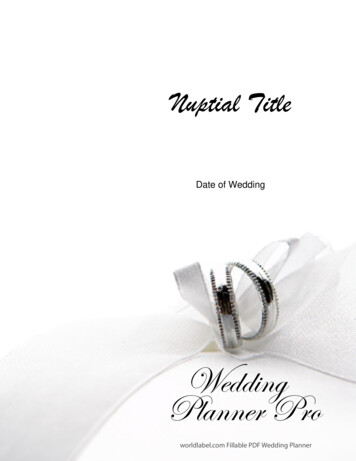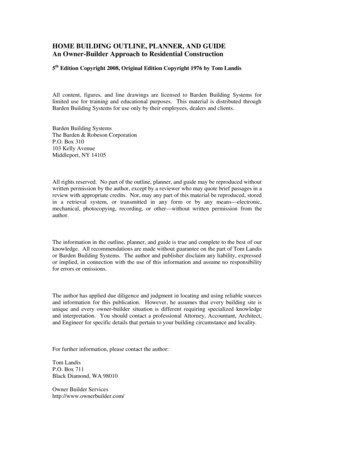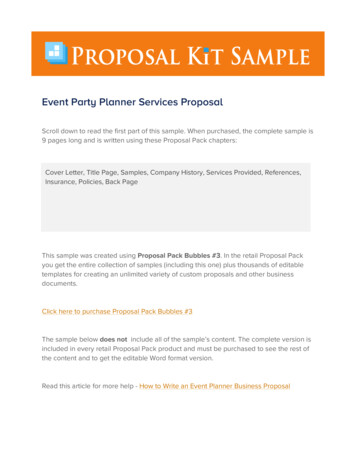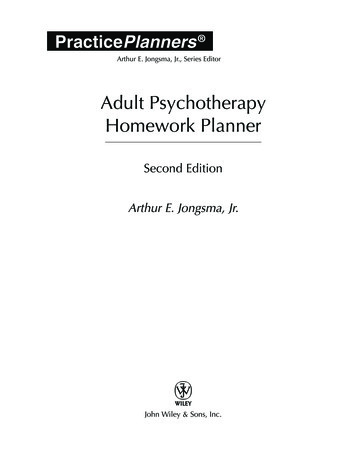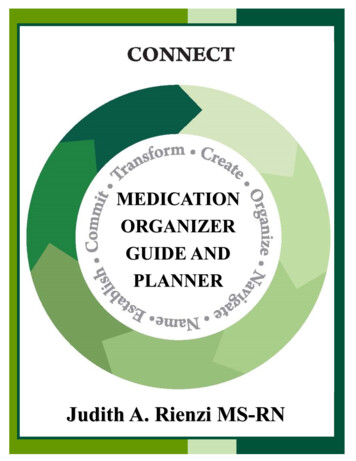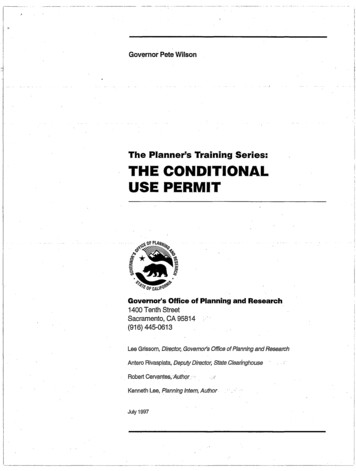
Transcription
----·---Governor Pete WilsonThe Planner's Training Series:THE CONDITIONALUSE PERMITGovernor's Office of Planning and Research1400 Tenth StreetSacramento, CA 95814(916) 445-0613Lee Grissom, Director; Governor's Office of Planning and ResearchAntero Rivasplata, Deputy Director; State ClearinghouseRobert Cervantes, Author ,Kenneth Lee, Planning Intern; AuthorJuly 1997
The Planner's Training SeriesThis publication is one in a series prepared by the Office of Planning and Research(OPR) on topics of general interest to planners. As with the rest of this series, itsprimary purpose is to provide both a reference for experienced planners and trainingmaterials for new planners, planning commissioners,and zoning board members.Citations are made to pertinent sections of the California statutes and to court decisionsin order to provide the reader the opportunity to do additional research on their owh.Unless otherwise noted, all statutory references are to the California Government Code.This document and other OPR publications, along with additional information aboutlocal government planning and zoning, is available from the LUPIN (Land Use Plan ning Information Network) web site maintained by the California Resources Agency athttp://ceres.ca.gov/planning/
IiThe CONDITIONAL USE PERMITWHAT IS A CONDITIONAL USE PERMIT?Aallows a city or county to consider special uses which may be essential ordesirable to a particular community, but which are not allowed as a matter of right within a zoningdistrict, through a public hearing process. A conditional use permit can provide flexibility within azoning ordinance. Another traditional purpose of the conditional use permit is to enable a municipality to control. certain uses which could have detrimental effects on the community (Neighborhood Action Group v. County ofCalaveras (1984) 156 Cal.App.3d 1176).CONDITIONAL USE PERMIT (CUP)Consideration of a CUP is a discretionary act. ACUP application tendered by a project proponent isconsidered at a public hearing and, if approved, isgenerally subject to a number ofpertinent conditions ofapproval. Depending on local ordinance requirements,hearings are typically held by a board of zoning, theplanning commission, or a zoning administrator. Theowners ofproperty near the site are sent advance noticeof the date, time, and place of the hearing.Examples of common uses allowed with a condi tional use permit can be found in any city or countyzoning ordinance. For example, Santa Rosa's zoningordinance lists uses which may be permitted withinsingle-family residential districts with a conditionaluse permit. These uses include churches, public orprivate schools, public building or utility structures,parking lots, temporary subdivision sales offices, andcommunity care and health care facilities. Chico'szoning ordinance lists various uses permitted with ause permit issued by either a planning director orplanning commission. These uses include temporaryamusement attractions, the placement of a building orstructure on a lot or parcel which has been moved fromanother lot or parcel, public buildings and facilities,parking or access located off-site from the site beingserved, private recreation centers, and planned devel opments. Each city or county may include in theirzoning ordinance a wide variety ofuses which they willpermit with a conditional use permit.may still use its provisions (Section 65803). The fol lowing is a brief examination ofthe authority and rulesunder which local governments act in issuing usepermits.Constitutional Authority:Local governments have the authority to enactlocal planning and land use regulations to protect thepublic health, safety, and welfare of their residentsthrough their police power. The "police power" pro vides the right to adopt and enforce zoning regulations,as long as they do not conflict with state laws. Thepolice poweris the basis for charter city zoning powers.(California Constitution, Article XI, Section 7)Statutory Authority:California code reiterates the Constitutional policepowers of cities and counties to enact zoning regula tions, but has little to say about CUPs in particular."The legislative body of any county or city may,pursuant to this chapter, adopt ordinances that do anyof the following:"Regulate the use ofbuildings, structures, and landas between industry, business, residences, open space,including agriculture, recreation, enjoyment of scenicbeauty, use ofnatural resources, and other purposes ."(Section 65850(a))("The board of zoning adjustment or zoning admin istrator shall hear and decide applications for condi tional uses or other permits when the zoning ordinanceprovides therefor and establishes criteria for determin ing those .matters .""The board of zoning adjustment or zoning admin istrator may also exercise any other powers granted bylocal ordinance and may adopt all rules and proceduresENABLING LEGISLATIONThe rules under which counties and general lawcities may issue a conditional use permit are provided,by state and case law. Charter cities are not subject tostate zoning law, except in special circumstances, but1
THE CONDITIONAL USE PERMITnecessary or convenient for the conduct of the board'sor administrator's business."(Section 6590l(a))adjustment or the zoning administrator (Section 65903 ).In most jurisdictions, appeals are heard by the nexthighest body, eventually reaching the city council orcounty board of supervisors for a final decision.Case Law:California case law has established a number offundamental principles relating to conditional use per mits. In addition to the basic uses permitted within azoning district, a city or county zoning ordinance canprovide other specified uses which may be permittedafter consideration and resolution by an administrativeagency that the proposed use is in the best interest ofpublic convenience and necessity and will not becontrary to the public health, morals, or welfare (Uptonv. Gray (1969) 269 Cal.App.2d 352).Local governments must have a complete andvalid general plan before they can issue conditional usepermits (Resource Defense Fund v. County of SantaCruz (1982) 133 Cal.App.3d 800 and NeighborhoodAction Group v. County of Calaveras (1984) 156Cal.App.3d 1176).The authority to consider conditional use permits,delegated to planning commissions or other adminis trative bodies by elected officials, must include stan dards of guidance. These standards of guidance areprovided to insure that the delegation of discretion toan administrative agency is not unbridled and,thus, notinvalid. The doctrine of the need of an ascertainablestandard to guide an administrative body applies wherethe legislative body of a city attempts to delegate itslaw-making functions (Stoddard v. Edelman (1970) 4Cal.App.3d 544).Public Hearing:Section 65905 requires a public hearing to be heldon an application for a conditional use permit. At aminimum, advance public notice, an opportunity to beheard, and a fair hearing are constitutional due process rights as explained inHorn v. CountyofVentura(l979)24 C.3d 605.The Government Code establishes minimum re quirements for public notice for counties and generallaw cities. Charter cities may adopt similar provisions.The notice of a public hearing must include: the date,time, and place of the hearing; the identity of thehearing body or officer (commonly the delegated boardof zoning adjustment or the zoning administrator); adescription of the proposal and the conditional usepermit process; and the location of the property in volved (Section 65094). Notice must be mailed to allproperty owners within 300 feet of the proposal's siteboundary at least 10 days prior to the public hearing.The names and addresses of owners are those listed onthe most current county equalized assessment roll.This requirement includes the owners ofproperty whichlie outside the city limits or county line (Scott v. lndianWells (1972) 6 C.3d 541). Notice must also be pub lished once in a newspaper of general circulation atleast 10 days before the hearing.Section 65030 recognizes the importance ofpublicparticipation in public hearings and expresses a clearlegislative intent that local agencies insure public par ticipation at every level of the conditional use permitprocess. The purposes of the public hearing is for thezoning board or zoning administrator to hear andconsider the opinions of the proponent and nearbyproperty owners prior to making their decision to eitherapprove or deny the conditional use permit. As a quasi judicial act, the approval of a conditional use permitrequires the board or administrator to adopt writtenfindings to support their action. Whether the proposalhas been approved or denied, the decision can beappealed to a higher body, usually the board ofappeals,the planning commission, or city council, in accor dance with the city or county zoning ordinance. Theappeals body may reverse or affirm, wholly or partly,or may modify the decision, and may make suchdecision as should be made, and its action is final(Section 65903).PROCEDUREThe approval of a conditional use permit is anadministrative, quasi-judicial act. It is not a change ofzone, but rather a project-specific change in the usesallowed on a specific property. Conditional use per mits do not involve the establishment of new codes,regulations, or policies. Instead, a conditional usepermit applies the provisions of the zoning ordinanceand its standards to the specific set of circumstanceswhich characterize the proposed land use. Cities andcounties have the authority to establish either a boardof zoning adjustment or a zoning administrator to hearand decide applications for conditional uses. Localordinance can establish specific procedures under whicha delegated board of appeals will hear and determineappeals from the decisions of the board of zoning2
THE CONDITIONAL USE PERMITSection 65903 delegates to local legislative bodiesthe authority to establish procedures for an appeal butnot the power to restrict the right of appeal. Thus, acounty zoning ordinance cannot attempt to restrict theright of appeal to solely the applicant and exclude thegeneral public, especially adjacent property owners(Concerned Citizens ofMurphys v. Jackson (1977) 72Cal.App.3d 1021).In order to encourage concurrent processing forthe purpose of expediting zone changes and generalplan amendments, Section 65862 provides that plan ning agencies may simultaneously process a consoli dated application which may include a use permit,rezoning, and general plan amendment if all threeapplications encompass the same property.notice and an opportunity to be heard had been pro vided either by the agency or by the applicant.The Permit Streamlining Act does not apply toadministrative appeals within a state or local agency(Section 65922). Therefore, if a permit is appealed to ahigher body there is no strict time frame within whichthe appeal must be heard.LIMITATIONS ONCONDITIONAL USE PERMITSAs a rule, conditional use permits do not authorizeuses that the zoning ordinance does not authorize, noruses not expressly authorized by the permit. The con ditional use permit includes conditions which limit theapplicant's authority to use the property. Under certainconditions, however, local governments may incorpo rate provisions from federal laws and broaden therange of uses permitted (Sports Arena Properties, Inc.v. City ofSan Diego (1985) 40 C.3d 808).It is often the case that local agencies follow ageneral set of standards in considering a conditionaluse permit. These standards are generally acceptablesince it is a near impossibility to devise standards tocover all possible situations in which a use permit canbe issued (Tustin Heights Association v. Board ofSupervisors (1959) 170 Cal.App.2d 619). There areseveral cases in which these standards have been up held.California Environmental Quality Act:Conditional use permits are subject to the Califor nia Environmental Quality Act (CEQA, Public Re sources Code Section 21000, et seq.). Prior to thepublic hearing on the proposed conditional use permit,the city or county must evaluate the proposal to deter mine whether or not it may have any significant ad verse effects on the environment. If the proposal is notexempt from environmental review, the city or countyis required to prepare either a negative declarationindicating that the conditional use permit will have nosignificant effect, or an Environmental Impact Report(BIR) which describes the potential negative impactsof the proposal and the means to avoid or lessen thoseimpacts. See the bibliography for a reference whichcan provide more information about the CaliforniaEnvironmental Quality Act.-- -.--General Welfare Standard:"The establishment, maintenance or conducting ofthe use for which a use permit is sought will not, underthe particular case, be detrimental to the public welfareor injurious to property or improvements in the neigh borhood" (Hawkins v. County of Marin (1976) 54Cal.App.3d 586).Permit Streamlining Act:The Permit Streamlining Act (Section 65920, etseq.) establishes time limits within which the reviewand approval or denial of a conditional use permitproposal must occur. For instance, if an BIR wascertified for a conditional use permit, the applicationmust be acted upon within one hundred eighty days·from the date of certification (Section 65950(a)(l)). Aproposal for which a negative declaration was adoptedor a CEQA exemption used must be acted upon withinsixty days of that action (Section 65950(a)(2)(3)). Aconditional use permit cannot be disapproved solely tocomply with these deadlines.The Permit Streamlining Act provides that failureto meet its deadlines will result in automatic approvalof the conditional use permit (Section 65956(b)). How ever, the permit can only be deemed approved ifpublicNuisance Standard:"Any use found to be objectionable or incompat ible with the character of the city and its environs dueto noise, dust, odors or other undesirable characteris tics may be prohibited" (Snow v. City ofGarden Grove(1961) Cal.App.2d 496).General Plan Consistency Standard:"Although use permits are not explicitly madesubject to a· general plan meeting the requirement ofstate law, that condition is necessarily to be impliedfrom the hierarchical relationship of landuse laws.3
THE CONDITIONAL USE PERMITThus, use permits are struck from the mold of thezoning law, the zonirig law must comply with the·adopted general plan, and the adopted general planmust conform with state law; the validity of the permitprocess derives from compliance with this hierarchy ofplanning laws (Neighborhood Action Group v. Countyof Calaveras (1984) 156 Cal.App.3d 1176).provide for these cases, the ability to apply for condi tional use permits allowing these uses is provided forby state law. In all cases, public notice and hearingmust be provided as discussed earlier."Granny" Units (Section 65852.1)". any city, including a charter city, county, orcity and county may issue a zoning·variance, specialuse permit, or conditional use permit fora dwelling unitto be constructed, or which is attached. to or detachedfrom, a primary residence on a parcel zoned for asingle-family residence, ifthe dwelling unit is intendedfor the sole occupancy ofone adult or two adult personswho are 62 years of age or over, and the area of floorspace of the attached dwelling unit does not exceed 30percent ofthe existing Ii ving area or the area ofthe floorspace of the detached dwelling unit does not exceed1,200 square feet.".Prior to approval of a conditional use permit underSection 65852.1, the city or county must find that theresident or residents meet the age criteria, and that thefloor area of the proposed unit does not exceed thatallowed by the statute. In accordance with the specialcircumstances provided in Section 65803, Section65852.1 applies to charter cities, as well as general lawcities.Zoning Consistency Standard:"To obtain a use permit, the applicant must gener ally show that the contemplated use is compatible withthe policies in terms of the zoning ordinances, and thatsuch use would be essential or desirable to the publicconvenience or welfare, and will not impair the integ rity and character ofthe zoned district or be detrimentalto the public health, safety, morals or welfare" (0 'Hagenv. Board ofZoning Adjustment (1971) 19 Cal.App.3d151).In addition to the general standards discussed,there also exist other limitations on conditional usepermits. Conditional use permits run with the land notthe applicant (Cohn v. County Board of Supen,isors(1955) 135 Cal.App.2d 180). That is, where condi tional use permits are concerned, all related propertyand personal rights are freely transferable, unless ex pressly prohibited by law (Anza Parking Corporationv. City of Burlingame (1988) 195 Cal.App.3d 855).Inversely, a conditional use permit may not lawfullylimit the permittee from transferring it with the landsince such a condition is beyond the power of thezoning authority (Anza, supra).The conditions which are imposed on a conditionaluse permit must be expressly attached to the permit andcannot be implied. For example, if a conditional usepermit contains language that restricts a building'sheight to five stories and requires the developer tosubmit and obtain planning-commission approval of alandscaping plan, among other things, the permit itselfdoes not imply a height limitation on trees within thedevelopment (Pacifica Homeowners' Association v.Wesley Palms Retirement Community (1986) 178Cal.App.3d 1147).Second Dwelling Units (Section 65852.2)"Notwithstanding Section 65901, every localagency shall grant a special use or a conditional usepermit for the creation of a second unit if the secondunit complies with all of the following:"(A) The unit is not intended for sale and may berented."(B) The lot is zoned for single-family or multi family use."(C) The lot contains an existing single-familydwelling."(D) The second unit is either attached to theexisting dwelling and located within the living area ofthe existing dwelling or detached from the existingdwelling and located on the same lot as the. existingdwelling."(E) The increased floor area ofan attached secondunit shall not exceed 30 percent of the existing livingarea."(F) The total area of floor space for a detachedsecond unit shall not exceed 1,200 square feet."(G) Requirements relating to height, setback, lotcoverage, architectural review, site plan review, fees,charges, and other zoning requirements generally ap-OTHER TYPES OFCONDITIONAL USE PERMITSState law also allows conditional use permits for"granny" units, second dwelling units, and mobile home parks. If a local zoning ordinance does not4
THE CONDITIONAL USE PERMITplicable to residential construction in the zone in whichthe property is located."(H) Local building code requirements which ap ply to detached dwellings, as appropriate."(I) Approval by the local health officer where aprivate sewage disposal system is being used, if re quired."Section 65852.2 also provides that any local agencymay, by ordinance, allow second units in single-familyand multifamily residential zones. Thus, a Section65852.2 conditional use permit is only required forsecond units when a local agency has not adopted anordinance governing second units.for making principled decisions, thus enhancing theintegrity of the administrative process; (2) helpingmake analysis orderly and reducing the likelihood thatthe agency will randomly leap from evidence to con clusion; and (3) serving a public relations function byhelping to persuade the parties that administrativedecision-making is careful, reasoned, and equitable.Findings should also justify any conditions whichimpose fees or other exactions.For a detailed discussion offindings requirements, seeOPR' s publication entitled Bridging the Gap.CONDITIONS OF APPROVALMobilehome Parks (Section 65852.7)"Amobilehome park, as defined in Sect
private schools, public building or utility structures, parking lots, temporary subdivision sales offices, and community care and health care facilities. Chico's zoning ordinance lists various uses permitted with a use permit issued by either a planning dire

